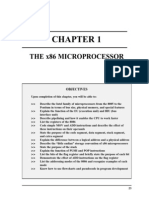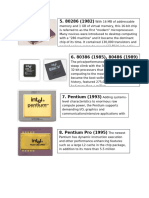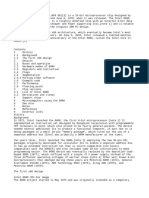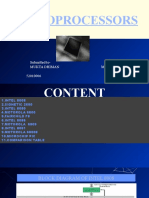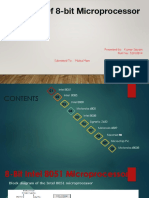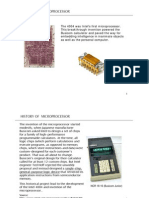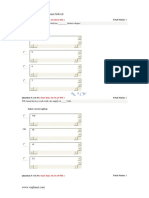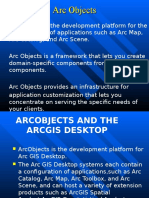Microp
Microp
Uploaded by
Naza RenkoCopyright:
Available Formats
Microp
Microp
Uploaded by
Naza RenkoOriginal Title
Copyright
Available Formats
Share this document
Did you find this document useful?
Is this content inappropriate?
Copyright:
Available Formats
Microp
Microp
Uploaded by
Naza RenkoCopyright:
Available Formats
Application for intel 4004The set of four chips was called the MCS-4.
It included a central processing uni t (CPU) chip the 4004, a supporting read-only memory (ROM) chip for the custom app lications programs, a random-access memory (RAM) chip for processing data, and a shift-register chip for the input/output (I/O) port. Intel delivered the four c hips and Busicom went on to sell some 100,000 calculators. * 4-bit microprocessor * 740 KHz * 4 KB program memory * 640 bytes data memory * 3-level deep stack * No interrupts
intel 8008The Intel 8008 was an early byte-oriented microprocessor designed and manufactur ed by Intel and introduced in April 1972. It was an 8-bit CPU with an external 1 4-bit address bus that could address 16KB of memory. * 8-bit microprocessor * 16 KB memory * Interupts
TMS 1000Texas Instruments TMS1000 family of 4-bit microcontrollers was introduced in 197 4. The TMS 1000 microcontrollers had very simple design - only 2 4-bit general r egisters, 43 instructions (expanded to 54 instructions in TMS1100/TMS1300), 1-le vel deep stack, shift-register program counter and no interrupts.
intel 4040The Intel 4040 microprocessor was the successor to the Intel 4004. It was introd uced in 1974. The 4040 employed a 10 m silicon-gate enhancement load PMOS technol ogy, was made up of 3,000 transistors[2] and could execute approximately 60,000 instructions per second. * 4-bit microprocessor * 740 KHz * 2 x 4 KB program memory * 640 bytes data memory * 7-level deep stack * No interrupts * 4004 object-code compatible 24-pin DIP
RCA 1802The RCA 1802 which is actually the one-chip implementation of the earlier two-chip RCA 1801 has a static CMOS design with no minimum clock frequency, so that it can be run at very low speeds and low power. It has an 8-bit parallel bus with a bi directional data bus and a multiplexed address bus (i.e., the high order byte of the 16-bit address and the low order byte of the address take turns in using th e 8-bit physical address bus lines, by accessing the bus lines in different cloc k cycles).
motorola 6800The 6800 is an 8-bit microprocessor produced by Motorola and released shortly af ter the Intel 8080 in late 1974.The 6800 is a standard "8-bit" 2's complement mi croprocessor, like the Intel 8080. It supports 8-bit bytes, 16-bit addresses and 64 KB of memory. Like the 8080, code can be placed in ROM. This is an important feature compared to some of the minicomputers of the time, especially the PDP-8 , which used a linked-list embedded in the code for subroutine linkage. The 6800 had a 16-bit stack pointer, so the stack can be located anywhere and ca n grow to any length up to the size of the memory. Compare this with the 6502 wh ich had only an 8-bit stack pointer and which mapped the stack into the second p age (addresses 256 - 511).
intel 8080The Intel 8080 was an early microprocessor designed and manufactured by Intel. T he 8-bit microprocessor was released in April 1974 running at 2 MHz (at up to 50 0,000 instructions per second), and is sometimes considered to be the first trul y usable microprocessor.
Signetics 2650The Signetics 2650, was a very early (1975) 8-bit microprocessor.The chip contai ned 7 8-bit general purpose registers, although only 4 were visible at any time. It was limited to a 15-bit address space (thereby addressing a maximum of 32KB of memory), since the upper bit of a 16-bit memory reference was reserved to ind icate that the indirect memory addressing mode was to be used (a minicomputer-li
ke feature).
fairchild f8Fairchild F8 or 3850 is a multi-chip microcontroller. The F8 is based on the 385 0 chip - this chip integrates 8-bit ALU, 64-bytes scratchpad RAM and two 8-bit I /O ports. The 3850 does not decode instructions - 3851 or 3856 program storage u nit (PSU) chips, dynamic memory interface (DMI) chip, 3853 static memory interfa ce (SMI) chip or 3861/3871 parallel I/O (PIO) chips are used for this task. If n ecessary, multiple PSU, DMI, SMI and PIO chips can be used together with one 385 0 ALU chip. The PSU chips include the following on-chip features: * * * * * ROM: 1 KB for the 3851 and 2 KB for the 3856 Memory addressing logic Two 8-bit I/O ports Interrupt logic Timer
SMI, DMI and PIO chips don't have on-chip ROM.
texas instruments tms9900Introduced in 1976 and based on the Texas Instruments 990 minicomputer CPU, the TMS9900 was one of the first true 16-bit microprocessors (the first were probabl y National Semiconductor IMP-16 or AMD-2901 bit slice processors in 16 bit confi guration). It was designed as a single chip version of the TI 990 minicomputer s eries, much like the Intersil 6100 was a single chip PDP-8, and the Fairchild 94 40 and Data General mN601 were both one chip versions of Data General's Nova. Un like the IMS 6100, however, the TMS 9900 had a mature, well thought out design. It had a 15-bit address bus, a 16-bit data bus, and three internal 16-bit regist ers (PC, WP, and ST). One unique feature, though, was that all general purpose u ser registers were actually kept in external memory. A single workspace register (WP) pointed to the 16 register set (each register being 16 bits wide) in RAM, so when a subroutine was entered or an interrupt was processed, only the single workspace register had to be changed - unlike some CPUs which required dozens or more register saves before acknowledging a context switch. This was feasible at the time because RAM was often faster than the CPUs. A few modern designs, such as the INMOS Transputers, use this same design using caches or rotating buffers, for the same reason of improved context switches. Other ch ips of the time, such as the 65xx series had a similar philosophy, using index r egisters, but the TMS 9900 went the farthest in this direction.
zilog z80The Zilog Z80 is an 8-bit microprocessor designed and sold by Zilog from July 19 76 onwards. It was widely used both in desktop and embedded computer designs as well as for military purposes. The Z80 and its derivatives and clones make up on e of the most commonly used CPU families of all time, and, along with the MOS Te
chnology 6502 family, dominated the 8-bit microcomputer market from the late 197 0s to the mid-1980s.
intel 8085The Intel 8085 is an 8-bit microprocessor introduced by Intel in 1977. It was bi nary-compatible with the more-famous Intel 8080 but required less supporting har dware, thus allowing simpler and less expensive microcomputer systems to be buil t. For the extensive use of 8085 in various applications, the microprocessor is pro vided with an instruction set which consists of various instructions such as MOV , ADD, SUB, JMP etc. These instructions are written in the form of a program whi ch is used to perform various operations such as branching, addition, subtractio n, bitwise logical and bit shift operations. More complex operations and other a rithmetic operations must be implemented in software. For example, multiplicatio n is implemented using a multiplication algorithm.
mostek3870Mostek was an integrated circuit manufacturer, founded in 1969 by ex-employees o f Texas Instruments.It have 8-bit microcomputer on a single MOS integrated circu it; N-Channel ion injection silicon-gate technology; the 3870 can execute the F8 instruction set of more than 70 commands, allowing expansion into multi-chip co nfigurations with software compatibility. The device features 2048 bytes of ROM, 64 bytes of scratchpad RAM, a programmable binary timer and interrupt, 32 bits of TTL compatible I/O and a single +5 V power supply requirement. The 3870 has 2048bytes of mask programmable ROM; the 38E70 has 2048 bytes of UV erasable PROM
Intel 8086In the 80386 microprocessor and later, virtual 8086 mode (also called virtual re al mode, V86-mode or VM86) allows the execution of real mode applications that a re incapable of running directly in protected mode while the processor is runnin g a protected mode operating system. VM86 mode uses a segmentation scheme identical to that of real mode (for compati bility reasons) which creates 20-bit linear addresses in the same manner as 20-b it physical addresses are created in real mode, but are subject to protected mod e's memory paging mechanism. -Memory addressing -Interrupts-When interrupts (both hardware, software and iret instruction) occur , the processor switches off the VM86 mode and returns to work in full protected mode to handle the interrupt. And before servicing the interrupt, the DS, ES, F
S, and GS registers are pushed on the new stack and zeroed. -64-bit support
motorola 6809-???????? OS-9 is a family of real-time, process-based, multitasking, multi-user, Unix-lik e operating systems, developed in the 1980s, originally by Microware Systems Cor poration for the Motorola 6809 microprocessor.
zilogz8000The Z8000 is a 16-bit microprocessor introduced by Zilog in 1979.Although fundam entally a 16-bit architecture, some versions had 7-bit, segment registers that e xtended the address space to 8 megabytes. The register set consisted of sixteen 16-bit registers, and there were instructi ons that could use them as 8-bit, 16-bit, 32-bit, and 64-bit registers. The regi ster set was completely orthogonal, with register 15 conventionally designated a s stack pointer, and register 14 for stack segment. There was both a user mode and a supervisor mode.
You might also like
- PlayStation Architecture: Architecture of Consoles: A Practical Analysis, #6From EverandPlayStation Architecture: Architecture of Consoles: A Practical Analysis, #6No ratings yet
- CS Paper 2 Notes Modify 2020Document106 pagesCS Paper 2 Notes Modify 2020hermoine gawarNo ratings yet
- Schematic Diagram of Ip Camera With EthernetDocument18 pagesSchematic Diagram of Ip Camera With EthernetnguyenminhtuanengineNo ratings yet
- 4thsem Microprocessor Notes PDFDocument148 pages4thsem Microprocessor Notes PDFVishal SharmaNo ratings yet
- MicroprocessorDocument12 pagesMicroprocessorMishalNo ratings yet
- Microprocessors and Its Applications EssayDocument15 pagesMicroprocessors and Its Applications EssayAshish BirwalNo ratings yet
- MPMC Mod-1Document32 pagesMPMC Mod-1Syeda AfreenNo ratings yet
- Intel 8086 Microprocessor FamilyDocument3 pagesIntel 8086 Microprocessor FamilyMusabbir Adnan TamimNo ratings yet
- Intel 4004Document2 pagesIntel 4004Johnedel RosalesNo ratings yet
- About 8086Document13 pagesAbout 8086Sunil KumarNo ratings yet
- The X86 Microprocessor & Alp: Microprocessors and MicrocontrollersDocument56 pagesThe X86 Microprocessor & Alp: Microprocessors and MicrocontrollersNaveen NNo ratings yet
- The X86 Microprocessor: ObjectivesDocument32 pagesThe X86 Microprocessor: Objectivespapikhu36100% (4)
- Unit-III Telugu AckDocument46 pagesUnit-III Telugu AckNarasimha Murthy YayavaramNo ratings yet
- List of Intel MicroprocessorsDocument61 pagesList of Intel Microprocessorsfireball993No ratings yet
- TO Micro Computer AND MicroprocessorDocument75 pagesTO Micro Computer AND MicroprocessorPiyush PandeyNo ratings yet
- Reviewer in ArchiDocument8 pagesReviewer in ArchiJeaniebhel OducaNo ratings yet
- X86 ArchitetureDocument17 pagesX86 Architetureseety2No ratings yet
- MicroprocessorDocument108 pagesMicroprocessorShailendra KumarNo ratings yet
- Microprocessor vs. MicrocontrollersDocument53 pagesMicroprocessor vs. MicrocontrollersArgie Omaga HuindaNo ratings yet
- Intel I3 ProcessorDocument8 pagesIntel I3 ProcessorArpit Upadhyay100% (1)
- Micro Controller Trainer ManualDocument30 pagesMicro Controller Trainer ManualMadiha Sher100% (1)
- Microprocessors SeminarDocument24 pagesMicroprocessors SeminarShobhit JainNo ratings yet
- Intel 8086Document4 pagesIntel 8086Shishir YalburgiNo ratings yet
- Microprocessor, Microcomputer and Assembly LanguageDocument48 pagesMicroprocessor, Microcomputer and Assembly LanguageKristine AbanadorNo ratings yet
- MicroprocessorsDocument25 pagesMicroprocessorsMohammad ArifNo ratings yet
- Introduction To Microprocessor 8085Document88 pagesIntroduction To Microprocessor 8085Dakwah IslamNo ratings yet
- Intel Microprocessor 8086,386, 486 & Pentium ProcessorDocument16 pagesIntel Microprocessor 8086,386, 486 & Pentium ProcessorUdit JainNo ratings yet
- Advanced Computer Architecture (ACA) /lecture: LV64-446, Module MV5.1Document101 pagesAdvanced Computer Architecture (ACA) /lecture: LV64-446, Module MV5.1fahadned5717No ratings yet
- Evolution of Microprocessor 2Document4 pagesEvolution of Microprocessor 2yayavaramNo ratings yet
- Arif MP Assig.Document25 pagesArif MP Assig.Satyam KumarNo ratings yet
- Chapter1 EvolutionDocument57 pagesChapter1 Evolutionmd shohanNo ratings yet
- 12-Bit Designs: Microprocessor Modes For The ArchitectureDocument4 pages12-Bit Designs: Microprocessor Modes For The ArchitectureLeandro MussoNo ratings yet
- Microp AssigDocument4 pagesMicrop AssigHamsewaany ImmanuelNo ratings yet
- Intel MicroprocessorDocument35 pagesIntel MicroprocessorLissa JusohNo ratings yet
- Lecture-1 Course No-312 (Microprocessor and Assembly Language Programming)Document42 pagesLecture-1 Course No-312 (Microprocessor and Assembly Language Programming)nazrul2islam_1No ratings yet
- Milestone of MicrocontrollersDocument2 pagesMilestone of MicrocontrollersJhay-r PanaNo ratings yet
- Intel CpusDocument37 pagesIntel Cpus我叫政揚UwUNo ratings yet
- Evolution of MicroprocessorsDocument22 pagesEvolution of MicroprocessorsGoutham KrishNo ratings yet
- Lecture - 1Document35 pagesLecture - 1alamin.sust57No ratings yet
- Reviewof Microprocessor PDFDocument23 pagesReviewof Microprocessor PDFSatyam KumarNo ratings yet
- Comparison of Intel Microprocessor 8086, 386, 486, Pentium IIDocument12 pagesComparison of Intel Microprocessor 8086, 386, 486, Pentium IIPulkit GoelNo ratings yet
- What Is Processor ?Document8 pagesWhat Is Processor ?Arya SinghNo ratings yet
- KL Intel D8086.jpgDocument12 pagesKL Intel D8086.jpgsapnarawa198799No ratings yet
- 8086 ArchitectureDocument15 pages8086 ArchitectureMadhuri PochaNo ratings yet
- Chapter 1:overview of 8085 MicroprocessorDocument34 pagesChapter 1:overview of 8085 Microprocessorzlight HagosNo ratings yet
- Computer Architecture and Organization: Intel 80386 ProcessorDocument15 pagesComputer Architecture and Organization: Intel 80386 ProcessorAtishay GoyalNo ratings yet
- Microprocessor NotesDocument140 pagesMicroprocessor NotesSaquibh ShaikhNo ratings yet
- 4/18/2018 Microprocessors - CP 423L1Document47 pages4/18/2018 Microprocessors - CP 423L1Ragnar AlonNo ratings yet
- 19/1/2011 Es C263: Microprocessor Programming and Interfacing 1Document15 pages19/1/2011 Es C263: Microprocessor Programming and Interfacing 1avireddy1No ratings yet
- A Study On MicropocessorDocument12 pagesA Study On MicropocessormanaskollamNo ratings yet
- AssignDocument2 pagesAssignSumit BhattiNo ratings yet
- Introduction To 8086Document91 pagesIntroduction To 8086sayyanNo ratings yet
- Architecture and Programming of x86 Processors: Microprocessor Techniques and Embedded SystemsDocument24 pagesArchitecture and Programming of x86 Processors: Microprocessor Techniques and Embedded SystemslimbusNo ratings yet
- Background: The First x86 DesignDocument6 pagesBackground: The First x86 Designmayur_5252No ratings yet
- Fall 2019/20 - Lecture Notes # 2: - Brief History of 80x86 Family of MicroprocessorsDocument16 pagesFall 2019/20 - Lecture Notes # 2: - Brief History of 80x86 Family of Microprocessorsrula mohammadNo ratings yet
- Familiarization With PC Components: Computer Hardware and Networking Lab (R707)Document93 pagesFamiliarization With PC Components: Computer Hardware and Networking Lab (R707)baazilpthampyNo ratings yet
- 8085 HistoryDocument20 pages8085 HistoryabhaysunderNo ratings yet
- Micro Processor2Document21 pagesMicro Processor2ezekiel nyamuNo ratings yet
- Mega Drive Architecture: Architecture of Consoles: A Practical Analysis, #3From EverandMega Drive Architecture: Architecture of Consoles: A Practical Analysis, #3No ratings yet
- NES Architecture: Architecture of Consoles: A Practical Analysis, #1From EverandNES Architecture: Architecture of Consoles: A Practical Analysis, #1Rating: 5 out of 5 stars5/5 (1)
- Master System Architecture: Architecture of Consoles: A Practical Analysis, #15From EverandMaster System Architecture: Architecture of Consoles: A Practical Analysis, #15Rating: 2 out of 5 stars2/5 (1)
- Computer Chess Programming TheoryDocument21 pagesComputer Chess Programming Theoryerdnase1902No ratings yet
- MCQ On MisDocument2 pagesMCQ On MisSmith0% (1)
- CS6004ES MS Coursework1Document3 pagesCS6004ES MS Coursework1Sowmi DaaluNo ratings yet
- HP PN5966 4167E - Passively Probing Motorola IBMPowerPC 603Document12 pagesHP PN5966 4167E - Passively Probing Motorola IBMPowerPC 603sirjole7584No ratings yet
- Shreyan CVDocument2 pagesShreyan CVVardaan TanejaNo ratings yet
- CS302 Quiz Solved For MID TERM PDFDocument25 pagesCS302 Quiz Solved For MID TERM PDFattiqueNo ratings yet
- Third Generation of ComputersDocument15 pagesThird Generation of ComputersHainah Kariza LeusNo ratings yet
- ARMMicro ControllerDocument2 pagesARMMicro ControllerDilip GunturuNo ratings yet
- Atif Iqbal: Atif - Iqbal@research - Iiit.ac - in Atif@students - Iiit.ac - inDocument4 pagesAtif Iqbal: Atif - Iqbal@research - Iiit.ac - in Atif@students - Iiit.ac - inAtif IqbalNo ratings yet
- Configuring Outband ManagementDocument6 pagesConfiguring Outband ManagementAlvaro CueNo ratings yet
- Netapp Aff A220Document63 pagesNetapp Aff A220Evgeniy100% (1)
- Online Investment and Loan Application: Tan WeiDocument87 pagesOnline Investment and Loan Application: Tan WeimafuyucNo ratings yet
- ExaLINK User GuideDocument44 pagesExaLINK User Guideopenid_fzOm6XxjNo ratings yet
- Wisp 2018.2 Nist CSF Mapping Example PDFDocument4 pagesWisp 2018.2 Nist CSF Mapping Example PDFEduardo Rios100% (1)
- ODI Incremental Load For Custom Table in OBI AppsDocument8 pagesODI Incremental Load For Custom Table in OBI AppsSuhel DayerNo ratings yet
- Browser Context FlowDocument18 pagesBrowser Context FlowWagdy TawfikNo ratings yet
- A Fixed-Point Type For OctaveDocument5 pagesA Fixed-Point Type For OctavegasrodriguezNo ratings yet
- Metro StateDocument5 pagesMetro Stateangelsong27No ratings yet
- Properties of Regular Languages: Prof. Busch - LSU 1Document29 pagesProperties of Regular Languages: Prof. Busch - LSU 1sat258No ratings yet
- Programming in C++ For BCA BIT BEDocument0 pagesProgramming in C++ For BCA BIT BEwww.bhawesh.com.npNo ratings yet
- Relational Algebra and Relational Calculus: Lecture FourDocument31 pagesRelational Algebra and Relational Calculus: Lecture FoursholihaturrahmahNo ratings yet
- AR1010/AR1011/AR1100 UART Open Source Linux Driver DocumentationDocument20 pagesAR1010/AR1011/AR1100 UART Open Source Linux Driver DocumentationmertkuzerNo ratings yet
- Introduction To ArcobjectsDocument57 pagesIntroduction To ArcobjectsPatrick GoNo ratings yet
- Basic Computer Concepts - IntroductionDocument4 pagesBasic Computer Concepts - IntroductionIanJoseph VelascoNo ratings yet
- PaperCut MF - Toshiba Embedded Manual PDFDocument58 pagesPaperCut MF - Toshiba Embedded Manual PDFBudau LaviniaNo ratings yet
- JonCarrier Dither Presentation FinalDocument14 pagesJonCarrier Dither Presentation FinalAdrian BottomleyNo ratings yet
- Modbus in Delta VDocument14 pagesModbus in Delta Vsrjsk1100% (2)
- Computer Graphics All Chapters (1-9)Document67 pagesComputer Graphics All Chapters (1-9)Fisseha Abebe100% (1)
- Migration To SAP Fiori - The Agile ApproachDocument13 pagesMigration To SAP Fiori - The Agile ApproachHari PavuluriNo ratings yet











